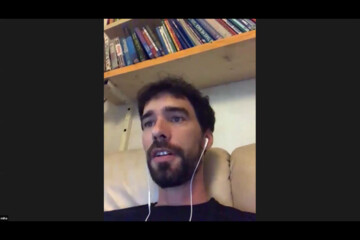On 18 October 2019, a revolt for life broke out in Chile, in the middle of a neoliberal oasis, in the Latin American jaguar and against all odds. I would like to propose the notion of revolt from this ongoing experience in order to address some key → situated elements with which to think about the uprisings that are now taking place in different latitudes and that enable a → process of radical political → imagination and questioning of the ways in which life is organised today.
→ After the collapse of the progressive tide of the 2000s, Latin America began to take an authoritarian turn as a shock response to the global economic recession and the ecosocial crisis that had been anticipated prior to the COVID-19 pandemic. This can be seen in the governments that are beginning to rule by closing borders, with austerity measures and reductions in public services and institutions, with negationist apologies and dogmatic neoconservative restitution, as well as with the extra-institutional responses where fundamentalist and neo-fascist groups have gained traction. In opposition to this and as an antagonistic alternative, in recent years protests and social outbursts have broken out that update and at the same time transform the modes of politicisation, repertoires of collective action and the very horizons of transformation of the left, which are pushing ever more radically towards a decolonising, → feminist and → anti-extractivist turn.
In 2019, the flame of the popular splendour was spreading in the Southern Cone. In September the indigenous organisations of Ecuador rose up against the IMF reform package, in October a revolt broke out in Chile triggered by the increase in public transport fares, in November a National Strike was organised in Colombia against the reduction of the minimum wage for young people and Duque’s pension reform, and in Bolivia, while the racist right-wing imposed itself through a coup d’état, raising Bibles and burning the whipala, once again a plurinational revolt emerged from below.
The destituent power
The October outbreak of unrest occurred after a call for mass fare evasion in the city’s subways. Hundreds of high school students gathered to jump turnstiles simultaneously at different stations on Santiago’s main artery and urban infrastructure, in protest at the fare hike of 30 pesos. No one understood then how it was possible that from this first gesture of student rebellion a general uprising would emerge from which there was no return. One after another, the Metro stations went up in flames, the barricades and looting of supermarkets multiplied, and in less than eight hours, the government declared war and decreed a State of Emergency. In the days that followed, time was suspended while the different cities and towns of Chile suffered a change of skin and name. Then a destituent moment broke out and with it the drive “that shook the bodies off the fear that had been embedded in them and made possible an unsuspected dance of new rhythms that began to fill the squares”[1]. An early image of this were the walls overflowed by the disparate and poetic insurgent graffiti in the blast of a politics of collective negativity. As Sarah Ahmed points out, for feminism saying “no” is a political act, that is why it repeats “no means no”, no to precarisation, fear and all the violence that passes through our bodies.[2] Along these lines, the no+, no more, began to multiply, “as a collective or plural speech”[3], “no+ abuses”, “no+ police”, “no+ impunity”, “no+ debts” and even on more than one occasion simply “no+” and that’s it. Those first isolated grammars of the revolt were followed by slogans that explicitly articulated the general and vital sense of the uprising “until life is worth living”, “they owe us a life”, “neoliberalism was born and will die in Chile”, “normal has always been the problem”. A revolt, unlike other processes of social mobilisation, necessarily implies the overflow of its own ignition, it is not a demand, a sector, nor a sheet, it is the destitute emergency of the administration of life.
This destituent quality unleashed an attack that is not only on the present, but also in terms of historical contestation. In Chile, this was illustrated with the slogan “it’s not 30 pesos, it’s 30 years”. The challenge, as peoples’ judgement, moved quickly from the 30 years of the post-dictatorship transition to the 47 years since the coup d’état and the 500 years of ongoing colonial violence. These layers of political, economic and symbolic violence gradually revealed the scope of what opened up the revolt as an exercise of historical imagination. The destituent power took the form of the collapse of a history that had been made into a heritage of monuments to colonisers, military generals and patriarchs. Christopher Columbus in Arica, Pedro de Valdivia in the Wallmapu, Francisco de Aguirre in La Serena, among other distinguished figures, who fell in the attacks of a demonumentalisation that were part of the “aesthetic disobedience”[4] and the epic of the decolonising power of the revolt. The alteration of these symbols of order that for centuries were thought to be imperturbable marked one of the points where the revolt began to twist its direction in an irreversible way.
It is typical of revolts that, after a few days, the cities make their new gravitational landmark, a paradigmatic square or place that was until then rather unremarkable. In Santiago this point was Plaza Italia, which used to mark the scar of urban segregation among those who lived above and below it, later renamed Plaza de la Dignidad, that is, Dignity Square. The tumultuous demonstrations took apart sidewalks and infrastructure with an agility that was unintelligible to the ruling sectors. This event appeared to the elites and government institutions as a total surprise which could take at least two forms: as a radical otherness that led them to represent this presence as an alien invasion, as the First Lady pointed out a few days after the outbreaks, or as a foreign geopolitical threat, as indicated by the Big Data report commissioned by the government that pointed to K-Pop fans as the postmodern incarnation of a foreign threat.
A displacement of the site of political violence is another feature that cuts across the shared intensity of a revolt. In the case of Chile, the previously marginalised figure of the hooded youth became resignified as “the front line”, deflecting the internalised criminalisation of extra-institutional violence. In front of the tanks of a militarised and bestial police force, the front line was a fragile-looking web of intertwined bodies from which some looked out with goggles or covered faces, others with no other protection than the bodies next to them, but almost always clinging to telephone poles and signs converted into shields painted in vibrant colours that evoked an unexpected dignity. In a very interesting twist, the Front Line does not seem to be identified, at least in the popular imagination, with the vanguard of the urban guerrilla tradition, but rather as the expression of a politics of → care (→ care) in the face of police and military violence, an ethic of hospitality that accompanies and protects those who have joined for the first time and also those who return after years of waiting, to the ecstatic tenderness of the destituent protest. The suspension of a normative judgment against this exercise of self-defence and direct action makes it visible, as never before legitimate, even appropriable by a wide range of people beyond the protestors. In any case, this is not a naive apology; the Front Line shows the most brutal aspects of neoliberalism in Chile, the constitution of a youth that has nothing to lose and so putting their bodies on the line is at the same time a sign of commitment and of desperation.
In the revolt, the dismantling of the city, the pavements and urban infrastructure are not alien to the experience of what is at once a rite, a meeting and a celebration of the recognition of a variegated us. In this last decade, the revolts have updated the signs of social struggle with new repertoires and imaginaries, some of which may be allusions to local idiosyncrasies that could be unintelligible to foreigners, as well as references to a radical pop cosmopolitanism. To illustrate this, I would like to dwell on a couple of images. First, “Aunt Pikachu”, a working class woman whose youngest son mistakenly spent $700 on AliExpress, including the purchase of an inflatable Pikachu costume. They resold everything except the costume, with the idea of keeping it for one of the Halloween parties that are celebrated with great intensity in Chile. But it wasn’t Halloween that arrived, it was the revolt, and the woman decided to join one of the first marches dancing while dressed as Pikachu with a pink rose and a presidential band, an image that went viral. The chant “Dance, Pikachu, dance” became an emblem and part of the mythology of the revolt. A second image is that of the Negro Matapacos, a dog who lived through the student protests of 2011 then, and after his death, became an icon of the street protest. His image with the red scarf around his neck is one of the most recognised symbols of the revolt in Chile, something like a mixed, → anti-fascist and multi-species announcement of an ongoing process. An iconic image that was soon replicated in other latitudes, even amidst the clamour of the BLM anti-racist protests against police brutality in the United States. This is how it became an internationalist emblem of revolt in neoliberal societies. In a similar way, an inescapable image was the performance Un violador en tu camino (“A rapist in your path”) by the collective LasTesis (who are currently being sued and harassed by the police in Chile). This common dance and cry against the “violence you don’t see” was a revolt within the revolt, returning to the intensity of the first days as it marked its own rhythm and a new regime of visibility. A feminist collective spell against police impunity and violence reverberated in the bodies and languages of women from different territories as a spontaneous contagion of international → solidarity that activated in each place its own layers of contestation.
Constituent drive
It is in the experience of this exceptional encounter, in the enunciation and confidence of this new “us”, that the possibility of revolt is born. It can be said that this is a drive that does not refer to institutional restitution or exit, but to the affirmation of something else. Of seeing ourselves again as a people, as a working class that is constituting itself in a process of undelayable struggle for another possible life. It is precisely the intensity of this experience that constitutes that place from which to enunciate new horizons of desire and radical contestation. The modes of production and reproduction of society, of life, are at the centre of the political problem of the revolt.
The revolt then advances in a contagious way, “from the contact that contaminates us mutually, staining each other, inhabiting the border with more strength than ever, letting ourselves be challenged by the one who has always been the other”[5]. The revolt is the restitution of a collective rumour that regenerates the broken tissues to enable popular assemblies of deliberation to emerge that are interspersed in the territories with nütram, networks of care, supply, solidarity and mutual support. Currently, the challenge has been to sustain the power of the revolt and the regeneration of the social fabric in the midst of physical isolation.
The revolt provokes the radical alteration of space-time and is thus a rupture, but also a return. It is the acceleration of a shared intensity that twists an order. In this case, the order of neoliberal normality from which a destituent desire emerged. But the very possibility of this untimely exception could not be understood without its legacies, without recognising the remains, the collective desires, the memory of struggle, of rage, of unrest and of all the forms of organisation sustained in previous times and that return to burst in as present and future.






